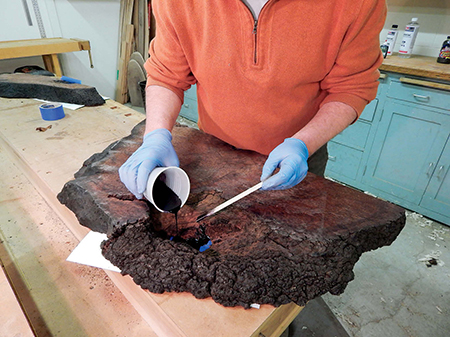
Here’s a great piece of wood to drool over. It’s a slab of redwood 38″ wide, 102″ long and 3″ thick. This woodworker wants to make a dining room table from it and wants advice on finishing it to protect it in terms of color and to prevent checking. It will be exposed to some elements on the covered porch, but not sunlight and rain. He lives in Southern California.
Michael Dresdner: Without sunlight or rain, all the wood needs is something that is flexible enough to tolerate the wood movement, which will be substantial, and something durable enough to endure whatever use it will get as a table. That could be anywhere from mild to wild. Assuming wild, I’d use an exterior urethane, and I’d coat it all around (both sides, all edges with extra soaking in the end grain). If it will see milder use, I’d go with spar varnish. Make sure whatever you choose contains enough mildewcide. (A good exterior material should.)
This is a perfect candidate for a flood on first coat, and for grain enhancement, too. Start by flooding the wood with pure boiled linseed oil. Use if full out ? no solvent added. Scrub it into the wood with a fine Scotchbrite pad. Let it sit at least 10 or 15 minutes, then wipe off whatever did not penetrate. Allow the oil to dry overnight. Now do the same thing with uncut exterior urethane, only this time you won’t have to let it sit that long before wipe-off. Make sure you keep soaking all the end grain until it stops absorbing the finish. The oil will help bring out depth and richness in the wood, and the urethane will help seal it evenly. When those two steps are done, and the first coat of polyurethane has dried overnight, go ahead and add as many more coats either by wiping or brushing as you see fit for appearance and durability. For high wear, a minimum of three coats brushed or at least twice that many wiped is a must. For low wear, it is strictly an appearance issue, so it is up to you.
By the way, that will help prevent surface checking, but not end checking. The only thing that will control that is if the piece was properly dried in the first place. If not, don’t bother working it or finishing it until you stabilize it and it is properly dried.
Ellis Walentine: You shouldn’t have any color or checking problems with redwood, but it wouldn’t hurt to use a varnish with a UV inhibitor in it. Oddly, the biggest problem with redwood for tabletops is that it’s so darn soft. It shows dings and scratches that most hardwoods shrug off. Assuming you want the table top to remain somewhat pristine, your best bet would probably be a polyurethane varnish. It will resist abrasion and scratching better than other varnishes and oil finishes. On the other hand, if you like that close-to-the-wood, satiny finish, you might want to try my old favorite, Waterlox, which is a thin wiping varnish. It protects well enough for dining table use, but it won’t resist abuse the way polyurethane will.
The standard advice on finishing questions is to try it on some scrap before you commit to the whole project. That way you get to know exactly how the various products handle, look and function.





